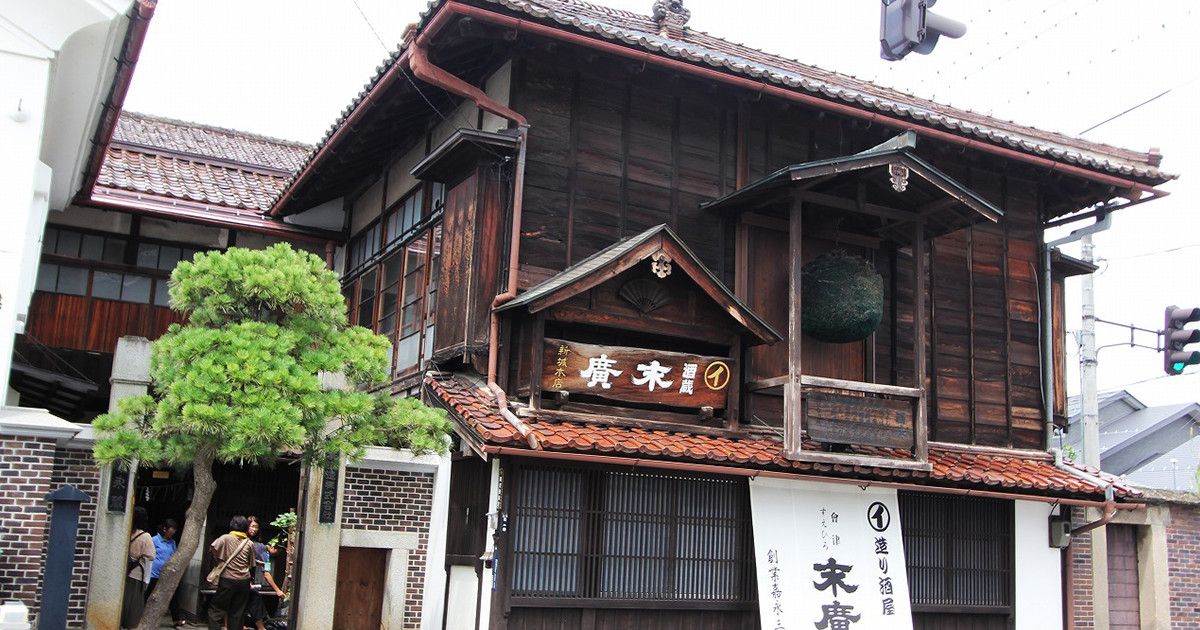Touring 165 years of tradition at
sake brewery Suehiro Shuzo
I headed upstairs to the second floor.
The stairway to the second floor seen from the entrance...upstairs was where the head of this brewery once lived.
There were times when, making and selling such expensive sake, he was able to give his children a life of luxury. In order to teach them how much hard work went into making sake, regardless of whether they were sons or daughters, he is said to have put them to work in the brewery among a staff comprised entirely of men.
A painting that shows what the sake brewery looked like in those olden days.
Like the custom in Korea, I imagined that women were absent in order to keep their “impurity” out (more than that later).
Though it seems to have been because making sake was hard work for women, and if even one or two were on hand to make meals, it led to arguments among the men, who lived in close quarters over a period of several months. So, from the start, women were not hired.
Ah…
I just imagined how doted upon I would be had I been born the daughter of a sake brewer back then.

At Kaeigura, there is even a photograph of the brewery owner’s family together with Hideyo Noguchi, the world famous scientist who also graces Japan’s ¥1000 note.
Who would’ve imagined he would show up in a photo here?

Noguchi was a native of Aizuwakamatsu and, as the head of the brewery in those days was good friends with him, is said to have visited often.
The tour over, I went down to the first floor for the tasting.
Shoji, the brewery manager, poured me some delicious sake samples.
These are junmai-shu sakes sold only at this brewery.
The sake available here at Kaeigura is the kind overflowing with devotion that you could only find in a place without modern equipment.
Even people who, like me, do not have a taste for sake will get excited with a mere whiff of their utterly unique aromas.
There was one sake in particular that caught my attention.
Junmai Daiginjo is a highly fragrant sake to begin with, but Suehiro Shuzo’s “Yume no Kaori” variety is, true to the Japanese name, fantastic for its dreamlike aroma.
Normally, in a place like Korea, Japanese sake would be drank from a soju cup. But I think a better vessel for this Yume no Kaori would be a wine glass- it is simply so fragrant!
I don’t drink all that much, but as someone who has enjoyed the particular aromas of the many Japanese sakes my husband drinks, I think I can say that I’ll remember this as the most special sake aroma I’ve ever experienced.
While it is an alcohol made from fermented rice, for me it is perfectly natural that this Yume no Kaori- true to sake’s English name “rice wine”- should be poured slowly into a wine glass, lightly swished, and drank while scrutinizing the aroma.
Why not make the trip to Suehiro Shuzo’s Kaeigura in Aizuwakamatsu? This is where they make the best Junmai Daiginjo as recognized by consumers: Yume no Kaori.
You may just encounter the aroma of your dreams.

Writer Kim Yanghyeon
Born in Korea but living in Saitama, Yanghyeon married a Japanese man in 2001, and started a blog in 2004 about life in Japan, travel, food, and culture etc. (http://miuki73.blog.me/ ) Elected four years in a row (2008-2012) for Naver blog’s foreign living category power blogger, this blog has amassed over 7,000 followers as of October 2017.










